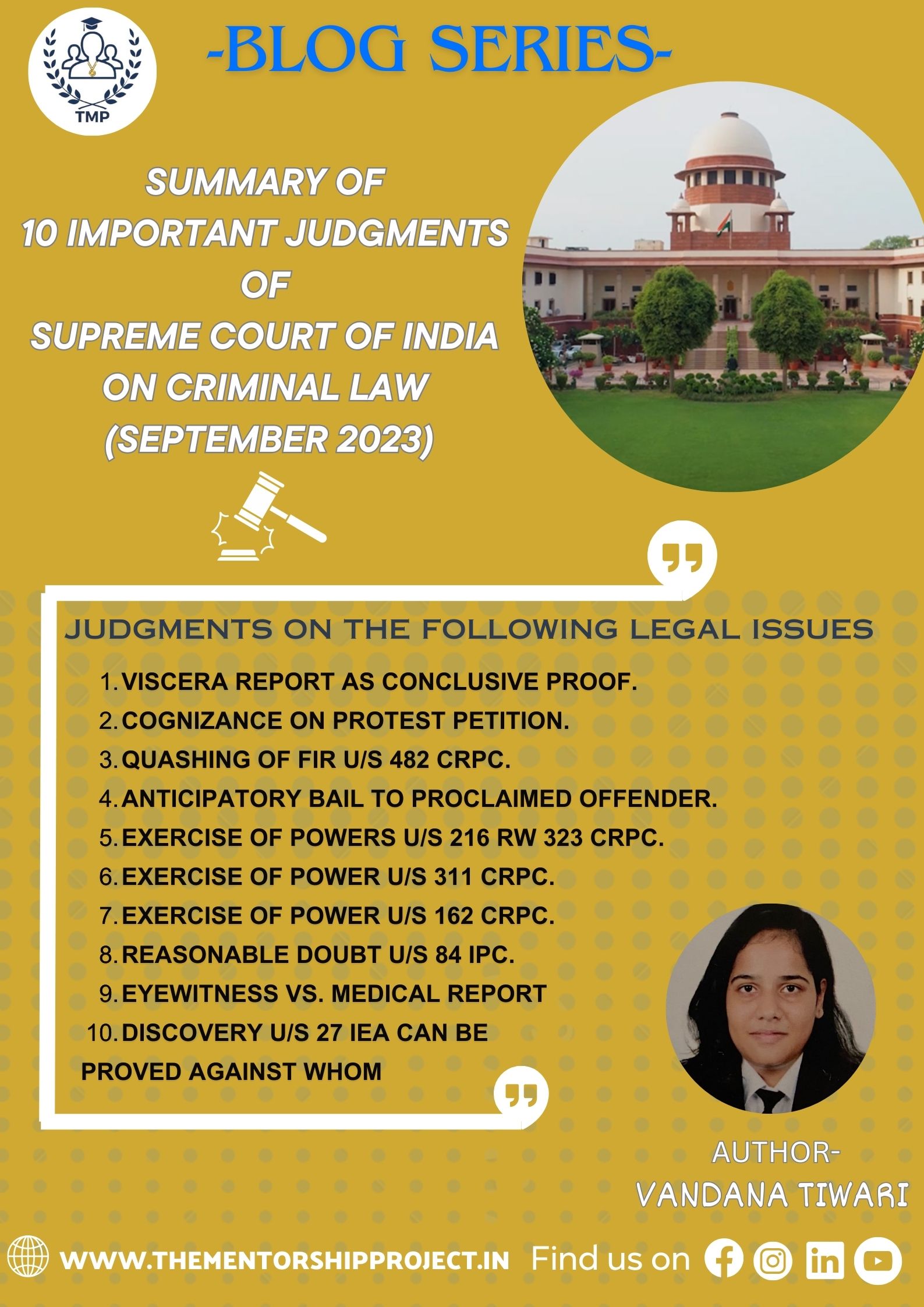September 13 , 2025
ARREST MECHANISMS IN INDIAN GST: LEGAL INSIGHTS AND INTERNATIONAL COMPARISON
Introduction
The Goods and Services Tax (GST) was enacted in 2017 in India. The main aim behind the enactment of this tax was to curb all the other taxes and convert them into a ‘One Nation, One Tax’. The revenue generated from taxes is used to fund defence and other essential government expenditures. This makes it crucial for everyone to pay their taxes honestly and on time. However, doing so is not always as straightforward as it might appear. In order to increase income and earn more profits, various businessmen indulge in fraudulent means of tax payments, where they not only steal high amounts of tax, but also lower the investment rate in the economy indirectly. Thus, various initiatives are taken by the Government to reduce the theft of taxes and protect the honest taxpayers. Additionally, the GST Act has various provisions regarding this initiative, which will be discussed below.
PROVISIONS IN THE GST ACT
- REASON TO BELIEVE
“Reason to believe” means when the officer has faith in the existence of facts for making justifications. GST Act provides for the relevant provisions which deal with the power to arrest, summon and bail. Section 69 of the GST Act states that any person can be arrested by officers if they have ‘reason to believe’ that the person has committed any offence under Section 132 of the CGST Act. Arrests can be made without filing an FIR (First Information Report) or any preliminary documentation. This often creates a legal lacuna not only limited to Centre GST, but also state GST, as all the provisions of state tax are not consistent with Centre tax, which leads to a lack of uniformity in the tax regime in the country.
This raises certain concerns, especially in large businesses:
- The arrest without an FIR can infringe legal rights enshrined in the Constitution of the country. This violates Article 21, which provides ‘personal liberty’ to all citizens. Officials can arrest any person whom they believe to have been involved in any offence against the concept of personal liberty, which states that no person should be deprived of basic rights; hence, this proves to be arbitrary and oppressive in nature. Taxpayer trust, along with economic fear towards businessmen, is yet another issue faced, which must be replaced by fair, constitutional filters at the earliest to ensure proper compliance and regulation.
- It also violates Article 19(1)(g)[ii], which deals with the right to practice any business, occupation and trade. Arbitrary arrest could enforce harsh tactics that could cripple the business. This could lead to dissolution of the firm in case any partner is arrested, who is innocent, can lead to a reduction in the goodwill of a business, causing financial losses, and an increase in liabilities. Closure of business could directly discourage customers and attract them towards other businesses; thus, sales could drop by a high number.
- Application of DK Basu Guidelines in GST Case Laws
Despite being tax administrators, GST officers function as police officers when they use their authority to arrest under Section 69 of the CGST Act. As a result, they must adhere to the procedural requirements of the CrPC as well as the protections established in D.K. Basu v. State of West Bengal, both constitutionally and procedurally. The Apex court in Radhika Aggarwal vs Union of India ruled that the exercise of arrest under the tax law does not release the authority from upholding Article 21. Certain principles that are taken from these guidelines by the court are as follows:
-
- The accused has to be informed of ‘reasons to arrest’ under Section 69(1) of the CGST Act that aligns with Article 21 and 19 of the Indian Constitution.
- The accused has to be given enough chance to inform relatives, friends or family members about the arrest.
- The arrestee has the right to consult the advocate for consultation of his case under which he/she is arrested.
While enforcing tax compliance, GST officers operate within a framework that respects the due process and fundamental rights of the individuals who are being arrested, thanks to this dual layer of protection. Moreover, the court also upheld in Radhika Aggarwal vs Union of India the constitutional validity of arrest provisions under this act. Thus, it was held that a person could apply for anticipatory bail even though no FIR has been registered against him.
COMPARATIVE ANALYSIS WITH OTHER JURISDICTIONS
Tax evasion could cause a huge loss to India’s economy by deterring its citizens access to equal facilities, due to which certain stringent provisions like arrest have been incorporated in the act, which aims to punish wilful taxpayers in order to deter them from committing these crimes in future. India, United States of America, and different countries in the European Union (hereinafter EU) have adopted distinct laws governing legal mechanisms for the regulation of taxes, including reformative and punitive measures. In India, arrest under the GST regime is governed by Sections 69 and 132 of the CGST Act, which allows tax authorities to arrest individuals without prior registration of an FIR. This pre-adjudicatory arrest power is intended to prevent large-scale fraud and ensure swift enforcement. But the constant misuse of these provisions has laid stress on the general public. The Supreme Court, in Akhil Krishan Maggu
v. DGGI, emphasised that arrest powers must not be exercised arbitrarily and should be backed by justifiable reasoning. In contrast, the EU implements a risk-based, audit-driven approach. Arrests in VAT fraud cases typically occur after thorough digital audits and evidence gathering, especially in cross-border fraud cases. The shift taken by the EU towards digital surveillance has minimised the discretionary power of enforcement agencies moreover, it reserves criminal prosecution only for high-value, intentional fraud cases.
Australia has yet to take a quite different approach. In this country, Taxation offices use data analytics and cross-agency intelligence to detect financial crimes, but arrests follow only after a full investigation, evidence collection, and sometimes judicial sanction. This helps to prevent any arbitrary arrest. Although India’s model is intended to deter fraud, and risks involving economic uncertainties, but it ends up leaving a grey area for arbitrary arrests. Unfortunately, this discourages investment from investors towards small businesses in lieu of fear of arrest and seizure of property under the ambit of the GST Act. Thus, sometimes there is a risk of arbitrary arrest by officials, which does not require compulsory prior assessment. This calls for reforms in arrest under this act, where India could possibly take lessons from other nations, such as the EU or Australia, by transforming itself into a tech-based surveillance system for making arrests and conducting investigations. A guideline could be formulated on a prior basis, which could make the assessment of crime more efficient.
The Supreme Court in 2024 directed the centre to release the data about the number of people arrested under the GST Act. This has been asserted in order to see whether the proper reason is supplied to the arrested person or not. A recent case in Jharkhand occurred wherein the Enforcement Directorate (hereinafter ED) conducted an investigation at over nine locations, including Ranchi, Kolkata, and Jamshedpur. The report claimed the fraudulent GST invoices were up to 800 Crores. The case illustrates the rationale behind the arrest provisions under Sections 69 and 132 of the CGST Act, intended to deter such frauds.
Conclusion
The arrest provisions under the GST Act have, to a certain extent, helped to curb the offences, which in turn act as a deterrent tool to prevent a person from committing offences under the act. These provisions differ from other countries in terms of punitive value. But sometimes, it also discourages honest individuals from investing their money in fear of ‘arbitrary arrest’. However, the law is not constant and is changing with time. Now, the provisions of arrest and bail under the Act have been scrutinised to meet the aim of the Act. The court has also intervened to improve certain aspects of the bill to improve its implementation. This signifies that law is ever-evolving and changes on a timely basis with the advent of technology.









